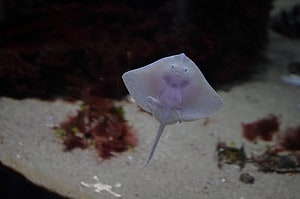There are many fascinating marine animals that have different adaptive abilities. From bioluminescence to extremely large teeth, there are several ways that fish evolved to protect themselves. Electrical shocks and envenomations are also on that list. But which adaptation is better? This article will investigate stingray vs. electric eels and who might win in a fight.

Electric eels can use electric pulses to sense prey in murky waters.
©iStock.com/Kseniia Mnasina
| Characteristic | Stingray | Electric Eel |
|---|---|---|
| Average Body Size | 10-100 pounds (varies greatly by species) | 45 pounds |
| Fastest Swimming Speed | 25 mph | 13 mph |
| Defense Mechanism | Envenomation | Electrical shock |
| Notable Behaviors | Nonconfrontational, stealthy | Nonconfrontational, stealthy |
What is a Stingray?
Stingrays are a fascinating group of fish that belong to the family Dasyatidae. They have flat, diamond-shaped bodies and long, whip-like tails with one or more venomous spines. There are numerous species and subspecies of stingrays found around the world, with some variations in their characteristics and distributions.
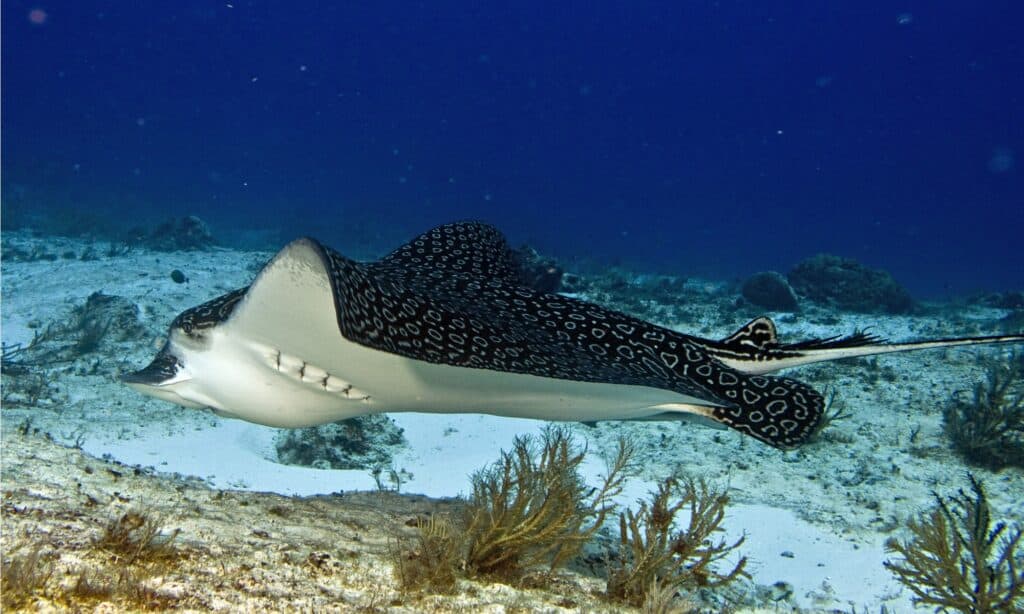
The spotted eagle ray has a stinging spine at the base of their tails, which they use for defense when threatened.
©iStock.com/eaglerayjoel
Stingrays are generally divided into two main groups: the stingrays and the electric rays. The stingrays, such as the common stingray (Dasyatis pastinaca) and the spotted eagle ray (Aetobatus narinari), have a stinging spine at the base of their tails, which they use for defense when threatened. Electric rays possess specialized electric organs that can generate electric shocks to stun prey and deter predators.
These animals can be found in various marine environments, including shallow coastal waters, estuaries, and coral reefs. They are distributed worldwide, with different species inhabiting different regions. For example, the giant freshwater stingray (Himantura chaophraya) is found in rivers of southeast Asia, while the short-tail stingray (Dasyatis brevicaudata) is native to the coastal waters of Australia and New Zealand. Some stingray species are migratory and travel long distances to feed or reproduce.
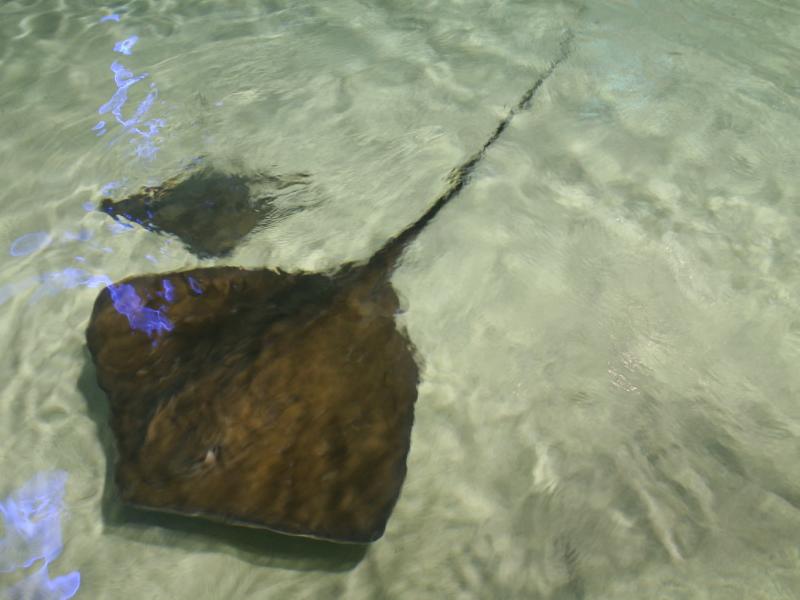
Stingrays live in shallow waters on the ocean floor where they hide from predators in the mud.
In terms of physical characteristics, stingrays have flattened bodies that enable them to glide gracefully through the water. They have large pectoral fins, which they use for propulsion, and eyes on top of their bodies to better detect predators and prey. Most stingrays are bottom dwellers that bury themselves in the sand or mud to camouflage and wait for food to pass by. They are generally carnivorous, feeding on a diet of small fish, crustaceans, and mollusks.
What is an Electric Eel?

The electric eel is found in freshwater, and uses its electric current to attack their prey.
©iStock.com/wrangel
Electric eels, scientifically known as Electrophorus electricus, are not true eels but rather a species of knifefish. They are remarkable creatures renowned for their ability to generate powerful electric shocks. Electric eels are found in the freshwater rivers and streams of the Amazon and Orinoco basins in South America.
Electric eels possess specialized electric organs that comprise about 80% of their bodies, allowing them to produce electric discharges. These discharges serve various purposes, including navigation, communication, and predation. By emitting high-voltage electric shocks, they can stun or immobilize prey, as well as deter potential threats.

Electric eels have long slender bodies.
©tristan tan/Shutterstock.com
Electric eels have an elongated, snake-like body that can reach lengths of up to 8 feet (2.5 meters) and weigh around 45 pounds (20 kilograms). They have a dark gray or brownish coloration that blends in with the muddy waters of their habitats. Despite their name, electric eels do not have gills and need to come to the water’s surface to breathe. These fascinating creatures can produce electric shocks in quick bursts or sustained currents. They have the ability to detect electric fields produced by other organisms, allowing them to locate prey even in dark or murky waters.
Electric eels are primarily carnivorous and feed on a diet of fish, invertebrates, and small mammals. They have a unique hunting strategy where they generate a series of low-voltage electric pulses, known as “hunting shocks,” to detect the presence and location of prey. Once the prey is located, the electric eel delivers a high-voltage shock to stun or immobilize it before consuming it.
Where Do Their Territories Overlap?
The territories of electric eels and stingrays can overlap in certain regions where both species inhabit freshwater systems. Specifically, in the Amazon and Orinoco basins of South America, where electric eels are found, stingrays can also be present in the same aquatic habitats. These areas encompass a vast network of rivers, streams, and flooded forests that provide diverse ecosystems for various aquatic species.
While electric eels predominantly inhabit freshwater environments, they are known to venture into brackish waters where rivers meet the ocean. In these transitional zones, stingrays can also be found. Thus, there are opportunities for electric eels and stingrays to coexist and share territories along the fringes of river systems.

Electric eels and stingrays overlap in many areas, including where rivers meet the sea. For example, they coexist at the mouth of the Amazon River.
©iStock.com/JarnoVerdonk
In such overlapping areas, electric eels and stingrays have adapted to their respective ecological niches. They often occupy different depths within the water column or have varying habitat preferences. This allows for some degree of partitioning and reduces direct competition. While electric eels and stingrays may share overlapping territories, they are not direct competitors for resources. Their different feeding preferences and ecological roles help reduce competition between the two species, enabling them to coexist in their shared habitats.
How Are They Potentially Harmful?
Electric Eel Shocks

The electric eel is found in freshwater, and use their electric current to attack their prey.
©Vladimir Wrangel/Shutterstock.com
An electric eel’s attack can deliver a potent shock. Electric eels can generate shocks of up to 600 volts, although the average discharge is usually around 300 to 400 volts. The electric potential or magnitude of an electric eel attack can vary. Factors such as the size and age of the eel, the intensity of the threat it perceives, and the distance from which it delivers the shock can vary. The shock feels like a powerful jolt that can cause muscular paralysis and temporary incapacitation or even loss of consciousness in extreme cases.
Stingray Envenomations
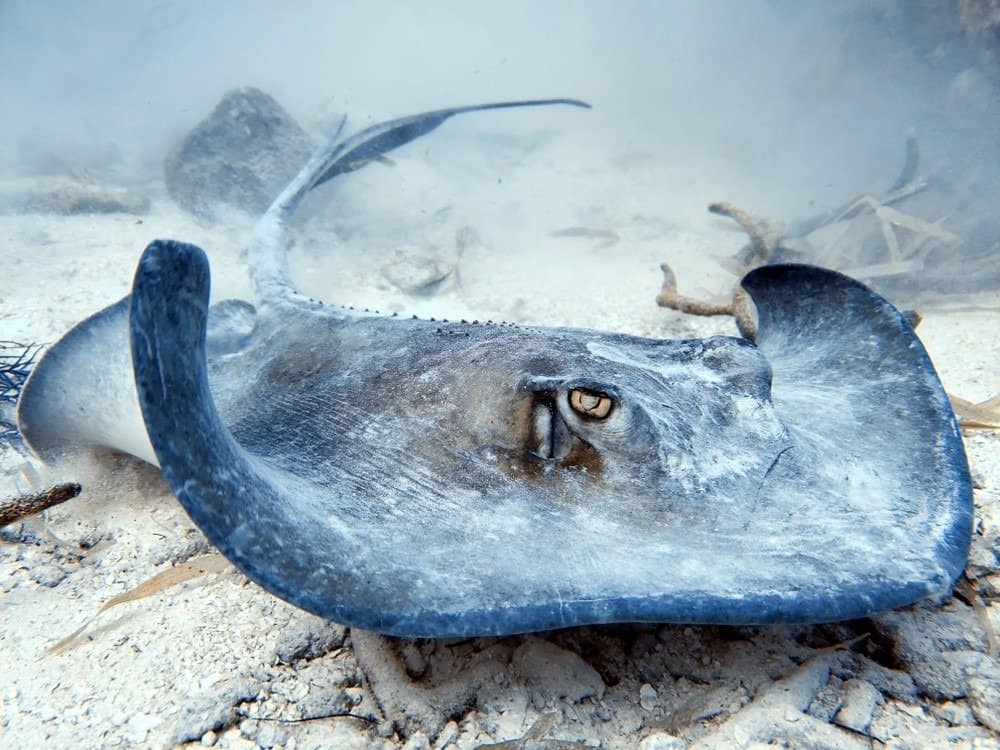
Stingrays have tails that bear venomous spikes.
©Nate Madden/Shutterstock.com
Stingrays, unlike electric rays, do not possess the ability to generate electric shocks. Instead, stingrays have venomous spines located at the base of their tails, which they use for defense when they feel threatened. The venom of a stingray is primarily proteins and peptides. It can cause severe pain, tissue damage, and other localized effects. The exact potency of the venom can vary between stingray species and individuals. When a stingray strikes with its spine, the venom is injected into the victim’s tissue.
Human Injuries
Electric eels generally do not pose a significant threat to humans unless provoked or mishandled. While incidents involving electric eels and human injuries do occur, reliable and up-to-date statistics on the exact number of people injured or killed by electric eels each year are not readily available. Furthermore, reporting and documenting such incidents may vary across different regions, making it challenging to provide an accurate estimate.
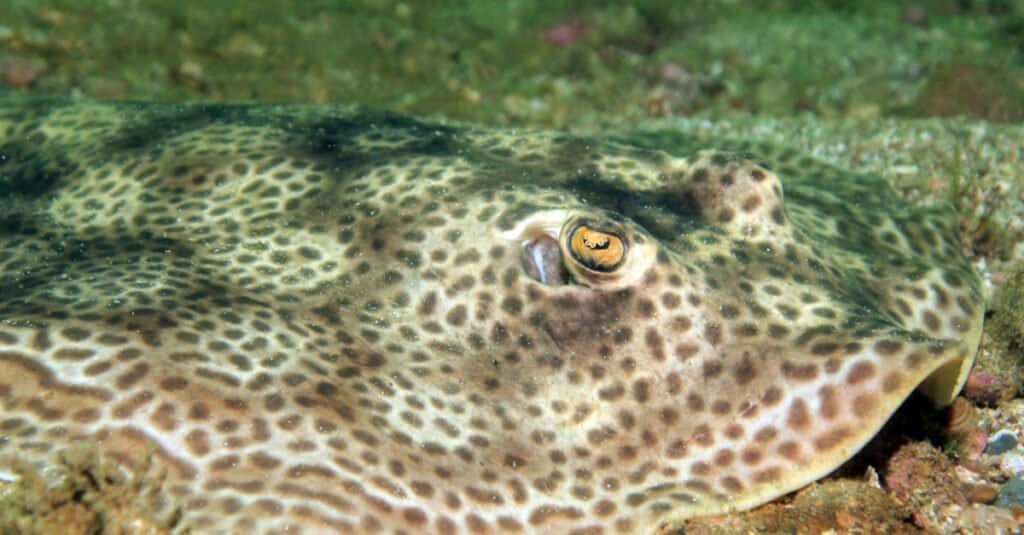
Stingrays have excellent camouflage skills. Be careful not to accidentally step on one.
©Daniel Lamborn/Shutterstock.com
Stingrays, although they possess venomous spines, are typically docile creatures and do not pose a significant threat to humans unless provoked or accidentally stepped on. Incidents involving stingray injuries or deaths are relatively rare. While it is challenging to provide precise figures, reports indicate that there are only a handful of serious injuries or fatalities globally each year due to stingrays. The majority of these incidents are a result of people inadvertently stepping on or disturbing them. This typically occurs in shallow coastal waters, leading to defensive stings. Many stingray encounters occur without harm. By taking appropriate precautions, such as shuffling your feet to alert stingrays of your presence, you can minimize the risk of injuries.
Stingray vs. Electric Eel: Who Would Win in a Fight?
It is challenging to determine a clear winner in a hypothetical fight between an electric eel and a stingray, as their characteristics and abilities are different. An electric eel’s electric discharges can be intense and potentially incapacitating to a stingray. Such shocks can allow it to stun or immobilize its target. To their disadvantage, however, electric eels are not built for physical combat. They would have to rely more on their electrical abilities than physical strength. Stingrays can employ their venomous spines when threatened. A stingray’s venom may cause pain, tissue damage, and other localized effects. They are not typically aggressive animals, however, and usually try to avoid confrontation rather than engage in combat.

Stingrays may potentially beat electric eels in a fight because of their size, speed, defense mechanisms, and stealth.
©Rich Carey/Shutterstock.com
Certain physical characteristics are important to consider, as well. Although some species of eels and stingrays overlap in weight, stingrays tend to be larger than eels. Stingrays can also typically swim faster than eels. Both traits, however, depend on the exact species being compared. In a hypothetical encounter, the outcome would depend on several factors. Considerations include the size and strength of the individuals involved, their defensive strategies, and the specific circumstances of the fight.
Ultimately, because stingrays are larger and faster than eels, possess venomous spikes, and have stealthy behaviors, stingrays would likely beat electric eels in a fight.
What other animals can deliver shocks or envenomations?

The electric
catfish
can discharge a shock of up to 450 volts to defend itself and capture prey.
©Pavaphon Supanantananont/Shutterstock.com
In addition to electric eels and stingrays, several other marine animals are capable of delivering shocks or envenomations. One such example is the electric catfish, found in freshwater habitats of Africa and South America. These catfish possess specialized electric organs similar to electric eels, allowing them to generate electrical discharges for navigation, communication, and defense.
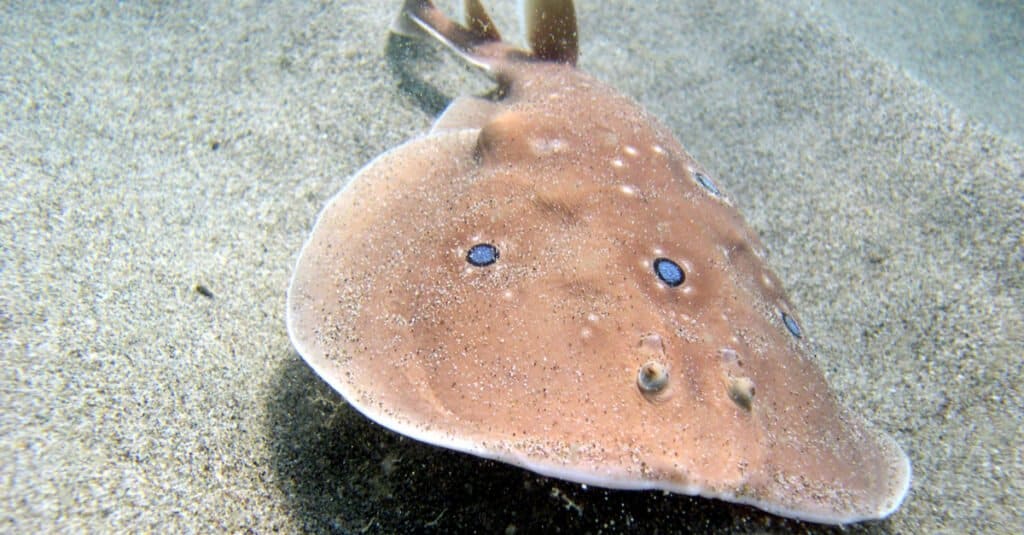
An electric torpedo ray can also deliver electrical shocks.
©Gennaro DiBs/Shutterstock.com
Another marine creature capable of delivering electric shocks is the electric torpedo ray. These flat-bodied rays have specialized organs called electrogenic tissue that can produce electric discharges. Electric torpedo rays primarily use their electric shocks to stun or immobilize prey and deter potential predators.

Box jellyfish are the world’s deadliest jellyfish.
©Danza/Shutterstock.com
When it comes to envenomation, certain species of jellyfish are well-known for their venomous stings. Box jellyfish, such as the infamous Chironex fleckeri, have tentacles covered in venomous cells called nematocysts. These nematocysts release toxins upon contact, causing painful stings and, in severe cases, potentially life-threatening reactions.
The photo featured at the top of this post is ©
Thank you for reading! Have some feedback for us? Contact the AZ Animals editorial team.



